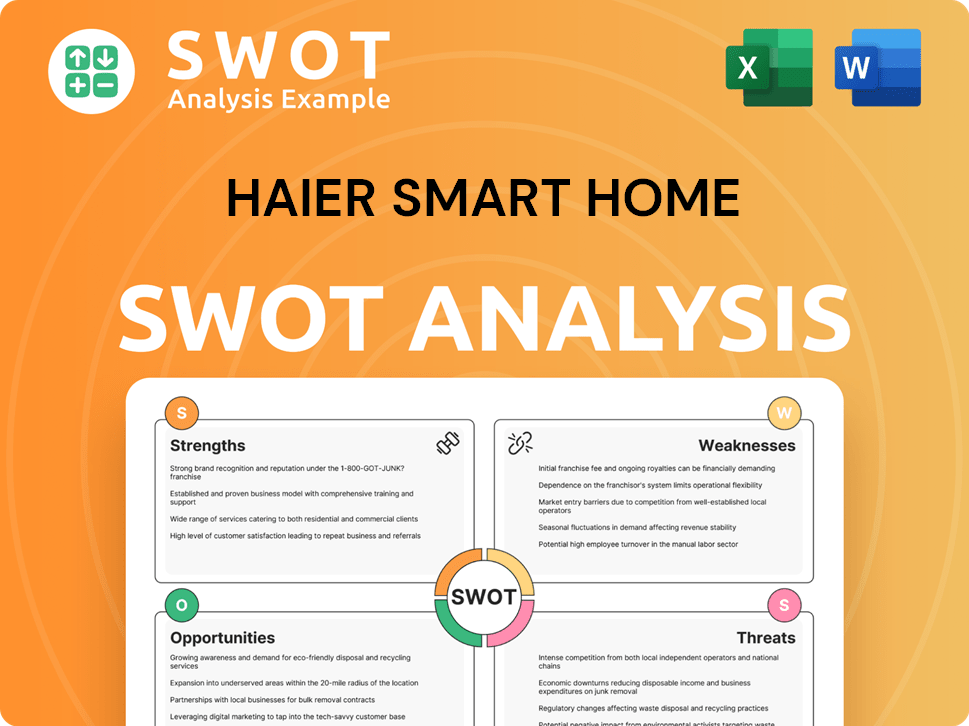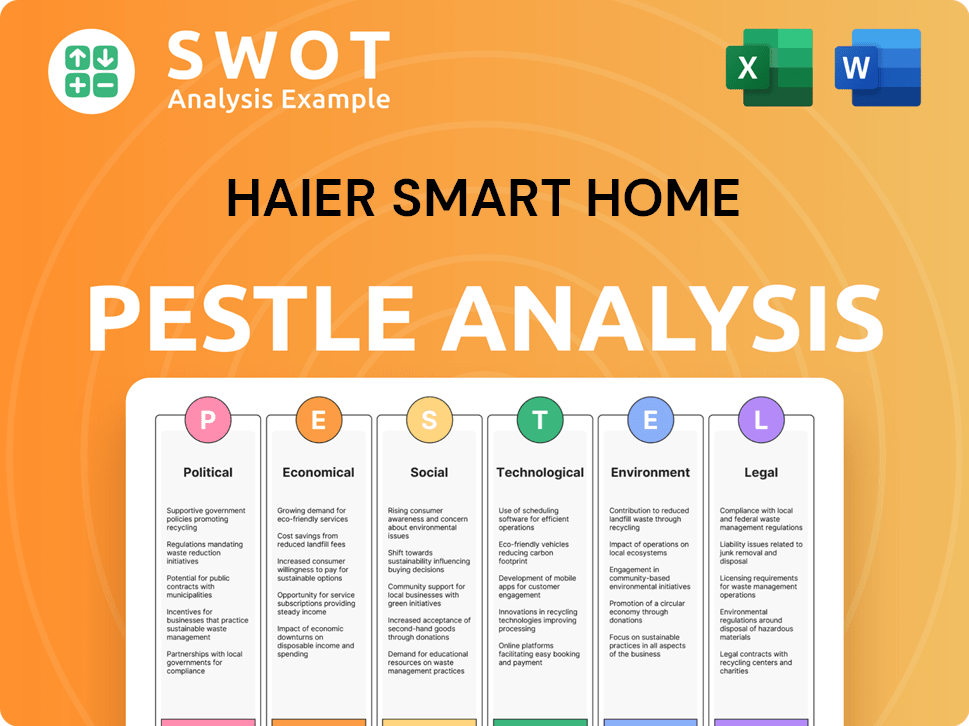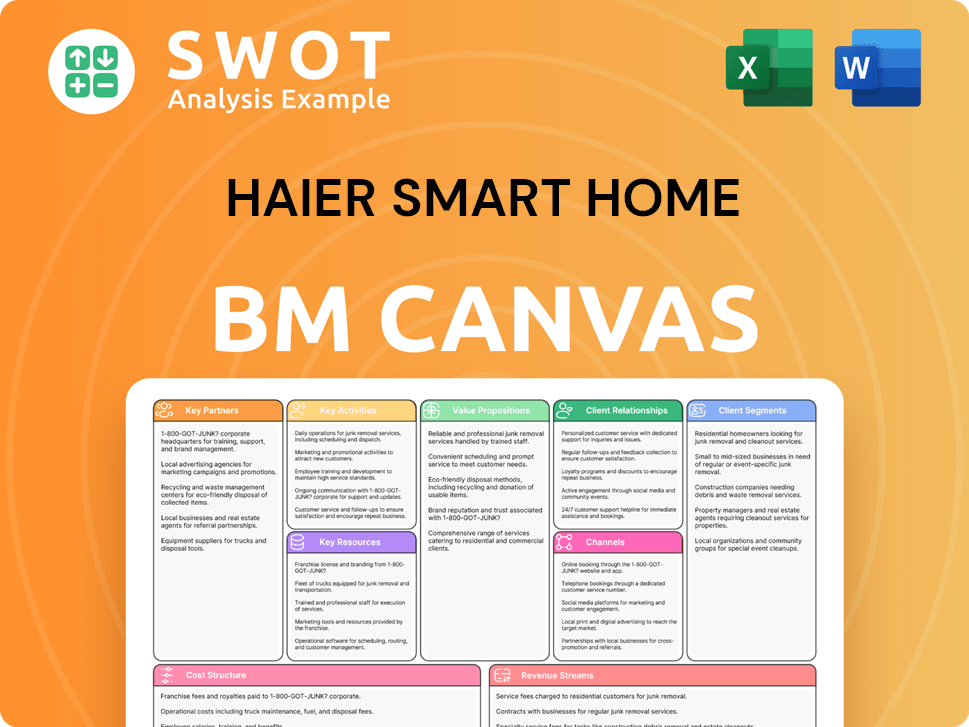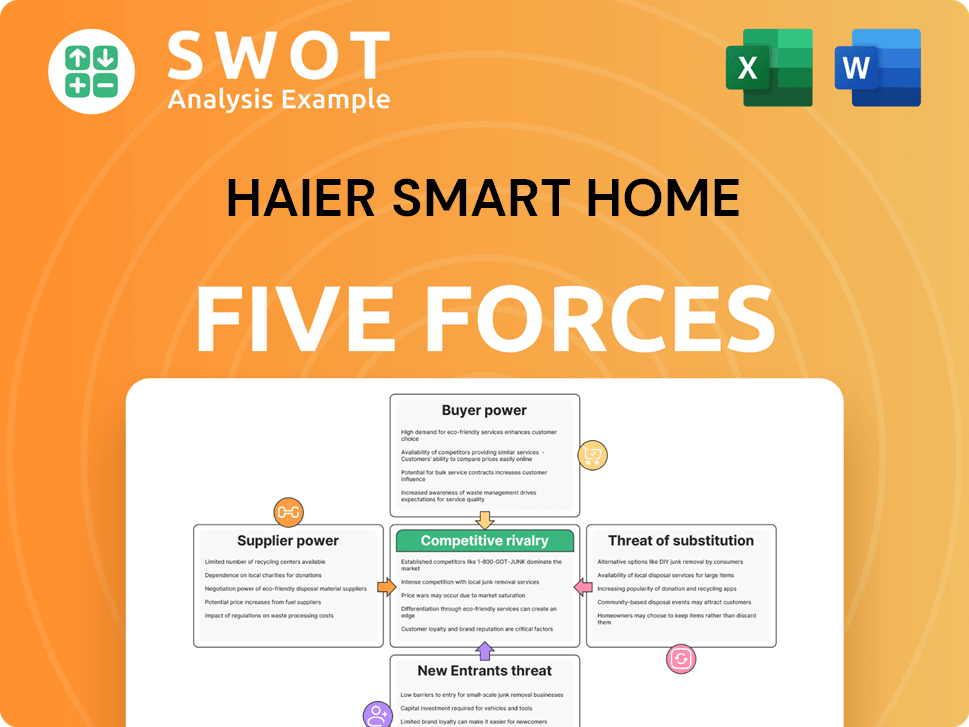Haier Smart Home Bundle
How Did Haier Smart Home Become a Global Leader?
Imagine a company that transformed from a struggling refrigerator factory into a global powerhouse. Haier Smart Home SWOT Analysis reveals the strategic brilliance behind this remarkable evolution. This is the story of Haier, a Chinese company that redefined the smart home industry, driven by relentless innovation and a commitment to quality.

The brief history of Haier Smart Home showcases its journey from producing basic Haier appliances to pioneering smart home technology. From its early days to its current status, the company's focus on quality and strategic acquisitions, including GE Appliances, fueled its global expansion. Understanding the evolution of Haier Smart Home is crucial for anyone interested in the dynamics of the smart home market and the strategies behind building a successful brand.
What is the Haier Smart Home Founding Story?
The Haier Smart Home story began on December 26, 1984. Zhang Ruimin was appointed director of the Qingdao Refrigerator General Factory. This marked the official start of what would become a leading smart home company.
At the time, the factory faced significant challenges, including debt and poor product quality. Zhang Ruimin, the founder, focused on overhauling operations and improving product reliability to meet consumer demand. This laid the groundwork for Haier's history and its future in the smart home market.
The initial focus was on manufacturing and selling refrigerators. The company's early success was driven by a commitment to quality, highlighted by Zhang Ruimin's famous sledgehammer incident in 1985, where he destroyed faulty refrigerators to emphasize the importance of quality control. Initial funding came from government loans and existing assets. The company later adopted the name 'Haier' in 1991, derived from a collaboration with the German refrigerator manufacturer Liebherr. This partnership was key in bringing advanced manufacturing techniques and quality standards to the company.
The early years of Haier were marked by a strong emphasis on quality and manufacturing excellence, which set the stage for its later expansion into the smart home market. The company's ability to adapt and innovate has been crucial to its success.
- 1984: Zhang Ruimin appointed director, marking the beginning of Haier.
- 1985: The sledgehammer incident, emphasizing quality control.
- 1991: The company adopted the name 'Haier.'
- Early focus on refrigerators, later expanding to other Haier appliances and smart home solutions.
The cultural and economic context of post-reform China significantly influenced Haier's creation and its initial focus on durable consumer goods. The company's success also reflects the broader trends in the Chinese economy during this time. For more insights into the company's values, you can read about the Mission, Vision & Core Values of Haier Smart Home.
Haier Smart Home SWOT Analysis
- Complete SWOT Breakdown
- Fully Customizable
- Editable in Excel & Word
- Professional Formatting
- Investor-Ready Format

What Drove the Early Growth of Haier Smart Home?
The early growth of Haier Smart Home was marked by a strong focus on improving product quality and expanding its range. Following its initial emphasis on quality, the Chinese company began diversifying beyond refrigerators. This strategic move set the stage for its evolution into a leading smart home company. The company's early success laid the groundwork for its future in smart home technology.
In 1988, Haier expanded its manufacturing capabilities by acquiring Qingdao Electroplating Factory and Qingdao Freezer General Factory. The early 1990s saw the introduction of washing machines, followed by air conditioners. These expansions were key to growing its market presence. As Haier appliances became more popular, the company's reputation for quality grew steadily.
The mid-1990s marked the beginning of Haier's international expansion, starting with developing markets. A significant milestone was the establishment of its first overseas factory in Indonesia in 1996. In 1999, Haier entered the United States, establishing a production facility in South Carolina. This move showed its ambition to compete in developed markets. The company's global strategy included acquiring local appliance manufacturers.
The company used its management principles, known as 'OEC' (Overall Every Control), to transform acquired companies. This allowed Haier to quickly increase its production capacity and market share. Zhang Ruimin continued to lead the company, emphasizing innovation and globalization. By the early 2000s, Haier had a strong presence in various product categories and regions, setting the stage for its future smart home ecosystem. For more information about the company, see Owners & Shareholders of Haier Smart Home.
Consumers increasingly valued Haier's commitment to quality and its expanding range of reliable home appliances. This positive reception helped the company grow. The company's focus on quality and expansion allowed it to establish a strong foundation in the market. This early growth was crucial for Haier's later success in the smart home market.
Haier Smart Home PESTLE Analysis
- Covers All 6 PESTLE Categories
- No Research Needed – Save Hours of Work
- Built by Experts, Trusted by Consultants
- Instant Download, Ready to Use
- 100% Editable, Fully Customizable

What are the key Milestones in Haier Smart Home history?
The Haier Smart Home journey is marked by significant milestones, reflecting its evolution from a Chinese company to a global leader in smart home technology. This Haier history showcases its strategic growth and innovation within the smart home company sector.
| Year | Milestone |
|---|---|
| Early 2000s | Introduction of the 'Rendanheyi' management model, empowering employees and fostering innovation. |
| 2000 | Launched the first internet-enabled refrigerator, marking an early entry into smart appliances. |
| 2016 | Acquired General Electric's appliance business for $5.4 billion, significantly expanding its global footprint. |
| 2019 | Acquired Candy S.p.A., further solidifying its global presence. |
The company's innovation is evident in its pioneering smart appliances and the development of interconnected platforms. Haier Smart Home has consistently introduced industry-firsts and secured numerous patents in areas like refrigeration, washing machine design, and smart home connectivity.
Launched the first internet-enabled refrigerator in 2000, showcasing early adoption of smart home technology. This innovation set the stage for future advancements in connected appliances.
Implemented the 'Rendanheyi' model, fostering entrepreneurship and responsiveness. This model allows employees to connect directly with user needs, driving innovation.
Developed interconnected platforms and AI-driven solutions to enhance user experience. This ecosystem approach integrates various Haier appliances seamlessly.
Secured numerous patents in refrigeration technology, washing machine design, and smart home connectivity. These patents protect its innovative designs and technologies.
Made strategic acquisitions, such as GE Appliances and Candy S.p.A., to expand its global presence and brand portfolio. These acquisitions have broadened its market reach.
Integrated AI-driven solutions into its smart home products to enhance user experience and efficiency. This integration improves appliance performance and user convenience.
Challenges for Haier Smart Home include intense competition and market downturns. The company has addressed these challenges through strategic acquisitions, continuous innovation, and its unique management model.
Faced intense competition from both domestic and international appliance manufacturers, requiring constant differentiation and technological advancement. This competition drives the need for continuous innovation.
Navigated market downturns, such as the global financial crisis, by focusing on efficiency and strengthening its global supply chain. This strategy ensured resilience during economic challenges.
Addressed the challenge of integrating diverse corporate cultures post-acquisition, using the Rendanheyi model to encourage local adaptation while maintaining core principles. This approach facilitated smooth integration.
Constantly advancing its technology to meet evolving consumer demands and stay ahead of competitors. This includes advancements in AI, connectivity, and energy efficiency.
Strengthening its global supply chain to ensure efficiency and resilience, particularly during economic uncertainties. This helps maintain a competitive edge in the market.
Responding to the ever-changing market dynamics and consumer preferences. This includes adapting to new technologies and emerging trends in the smart home sector.
Haier Smart Home Business Model Canvas
- Complete 9-Block Business Model Canvas
- Effortlessly Communicate Your Business Strategy
- Investor-Ready BMC Format
- 100% Editable and Customizable
- Clear and Structured Layout

What is the Timeline of Key Events for Haier Smart Home?
The Haier Smart Home journey began in 1984, evolving from a Qingdao refrigerator factory to a global leader in smart home technology. This Chinese company, through strategic acquisitions and innovative product development, has significantly impacted the smart home industry. Haier history is marked by a commitment to quality and a vision for a connected living experience.
| Year | Key Event |
|---|---|
| 1984 | Zhang Ruimin becomes director of Qingdao Refrigerator General Factory, marking the beginning of the company's transformation. |
| 1985 | Zhang Ruimin destroys defective refrigerators, emphasizing quality control as a core value. |
| 1991 | The company officially adopts the name 'Haier,' establishing its brand identity. |
| 1996 | Haier establishes its first overseas factory in Indonesia, initiating its global expansion. |
| 1999 | A production facility is established in the United States, further expanding its global presence. |
| 2000 | Haier introduces its first internet-enabled refrigerator, entering the smart home market. |
| Early 2000s | Haier implements the 'Rendanheyi' management model, focusing on employee empowerment and customer value. |
| 2006 | Haier acquires the former domestic appliance business of Sanyo Electric Co., Ltd., in Japan and Southeast Asia. |
| 2016 | The company acquires General Electric's appliance business for $5.4 billion, significantly expanding its market share. |
| 2019 | Haier acquires Candy S.p.A., an Italian appliance manufacturer, strengthening its European market presence. |
| 2023 | Haier is ranked the number one major appliance brand globally for the 15th consecutive year by Euromonitor International. |
| 2024 | Haier Smart Home continues to expand its smart home ecosystem, emphasizing AI and IoT integration. |
Haier Smart Home is focusing on the Internet of Things (IoT) and artificial intelligence (AI). This includes integrating these technologies into its appliances. The company aims to enhance user experiences through personalized and seamless smart home solutions.
The company plans to deepen its presence in developed markets. It also aims to explore opportunities in emerging economies. This strategy is designed to increase its global footprint and market share.
Haier is building a comprehensive smart home ecosystem. This involves connecting various appliances and devices. The goal is to provide users with a unified and intuitive smart living experience.
There is a growing demand for energy-efficient appliances. Haier is responding by developing sustainable products. This includes integrating features that reduce energy consumption and environmental impact.
Haier Smart Home Porter's Five Forces Analysis
- Covers All 5 Competitive Forces in Detail
- Structured for Consultants, Students, and Founders
- 100% Editable in Microsoft Word & Excel
- Instant Digital Download – Use Immediately
- Compatible with Mac & PC – Fully Unlocked

Related Blogs
- What is Competitive Landscape of Haier Smart Home Company?
- What is Growth Strategy and Future Prospects of Haier Smart Home Company?
- How Does Haier Smart Home Company Work?
- What is Sales and Marketing Strategy of Haier Smart Home Company?
- What is Brief History of Haier Smart Home Company?
- Who Owns Haier Smart Home Company?
- What is Customer Demographics and Target Market of Haier Smart Home Company?
Disclaimer
All information, articles, and product details provided on this website are for general informational and educational purposes only. We do not claim any ownership over, nor do we intend to infringe upon, any trademarks, copyrights, logos, brand names, or other intellectual property mentioned or depicted on this site. Such intellectual property remains the property of its respective owners, and any references here are made solely for identification or informational purposes, without implying any affiliation, endorsement, or partnership.
We make no representations or warranties, express or implied, regarding the accuracy, completeness, or suitability of any content or products presented. Nothing on this website should be construed as legal, tax, investment, financial, medical, or other professional advice. In addition, no part of this site—including articles or product references—constitutes a solicitation, recommendation, endorsement, advertisement, or offer to buy or sell any securities, franchises, or other financial instruments, particularly in jurisdictions where such activity would be unlawful.
All content is of a general nature and may not address the specific circumstances of any individual or entity. It is not a substitute for professional advice or services. Any actions you take based on the information provided here are strictly at your own risk. You accept full responsibility for any decisions or outcomes arising from your use of this website and agree to release us from any liability in connection with your use of, or reliance upon, the content or products found herein.